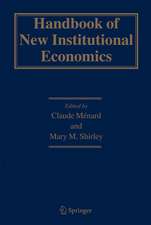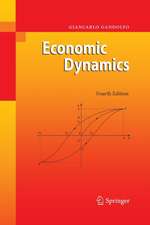Regime Transitions, Spillovers and Buffer Stocks: Analysing the Swiss Economy by Means of a Disequilibrium Model: Lecture Notes in Economics and Mathematical Systems, cartea 360
Autor Peter Stalderen Limba Engleză Paperback – 12 iun 1991
Din seria Lecture Notes in Economics and Mathematical Systems
-
 Preț: 360.02 lei
Preț: 360.02 lei -
 Preț: 383.93 lei
Preț: 383.93 lei -
 Preț: 384.09 lei
Preț: 384.09 lei -
 Preț: 380.07 lei
Preț: 380.07 lei -
 Preț: 446.26 lei
Preț: 446.26 lei -
 Preț: 497.37 lei
Preț: 497.37 lei -
 Preț: 380.84 lei
Preț: 380.84 lei -
 Preț: 384.86 lei
Preț: 384.86 lei -
 Preț: 378.34 lei
Preț: 378.34 lei -
 Preț: 399.67 lei
Preț: 399.67 lei - 20%
 Preț: 360.93 lei
Preț: 360.93 lei - 15%
 Preț: 643.16 lei
Preț: 643.16 lei -
 Preț: 379.09 lei
Preț: 379.09 lei -
 Preț: 404.74 lei
Preț: 404.74 lei -
 Preț: 385.62 lei
Preț: 385.62 lei - 15%
 Preț: 644.49 lei
Preț: 644.49 lei -
 Preț: 379.09 lei
Preț: 379.09 lei -
 Preț: 345.50 lei
Preț: 345.50 lei -
 Preț: 425.80 lei
Preț: 425.80 lei -
 Preț: 378.34 lei
Preț: 378.34 lei - 18%
 Preț: 775.65 lei
Preț: 775.65 lei -
 Preț: 392.60 lei
Preț: 392.60 lei -
 Preț: 401.61 lei
Preț: 401.61 lei - 15%
 Preț: 646.43 lei
Preț: 646.43 lei -
 Preț: 382.18 lei
Preț: 382.18 lei -
 Preț: 378.34 lei
Preț: 378.34 lei - 15%
 Preț: 637.59 lei
Preț: 637.59 lei - 15%
 Preț: 647.27 lei
Preț: 647.27 lei -
 Preț: 377.73 lei
Preț: 377.73 lei -
 Preț: 447.84 lei
Preț: 447.84 lei - 15%
 Preț: 644.49 lei
Preț: 644.49 lei -
 Preț: 386.00 lei
Preț: 386.00 lei - 15%
 Preț: 654.43 lei
Preț: 654.43 lei -
 Preț: 415.02 lei
Preț: 415.02 lei -
 Preț: 411.54 lei
Preț: 411.54 lei -
 Preț: 398.92 lei
Preț: 398.92 lei -
 Preț: 398.92 lei
Preț: 398.92 lei -
 Preț: 392.75 lei
Preț: 392.75 lei - 15%
 Preț: 635.47 lei
Preț: 635.47 lei - 20%
 Preț: 653.56 lei
Preț: 653.56 lei -
 Preț: 379.86 lei
Preț: 379.86 lei -
 Preț: 495.46 lei
Preț: 495.46 lei -
 Preț: 447.99 lei
Preț: 447.99 lei -
 Preț: 378.71 lei
Preț: 378.71 lei - 15%
 Preț: 637.13 lei
Preț: 637.13 lei -
 Preț: 385.84 lei
Preț: 385.84 lei -
 Preț: 378.54 lei
Preț: 378.54 lei - 15%
 Preț: 666.55 lei
Preț: 666.55 lei -
 Preț: 380.07 lei
Preț: 380.07 lei
Preț: 384.86 lei
Nou
Puncte Express: 577
Preț estimativ în valută:
73.64€ • 76.70$ • 61.39£
73.64€ • 76.70$ • 61.39£
Carte tipărită la comandă
Livrare economică 28 martie-11 aprilie
Preluare comenzi: 021 569.72.76
Specificații
ISBN-13: 9783540540564
ISBN-10: 3540540563
Pagini: 208
Ilustrații: VI, 193 p.
Dimensiuni: 170 x 244 x 11 mm
Greutate: 0.34 kg
Ediția:Softcover reprint of the original 1st ed. 1991
Editura: Springer Berlin, Heidelberg
Colecția Springer
Seria Lecture Notes in Economics and Mathematical Systems
Locul publicării:Berlin, Heidelberg, Germany
ISBN-10: 3540540563
Pagini: 208
Ilustrații: VI, 193 p.
Dimensiuni: 170 x 244 x 11 mm
Greutate: 0.34 kg
Ediția:Softcover reprint of the original 1st ed. 1991
Editura: Springer Berlin, Heidelberg
Colecția Springer
Seria Lecture Notes in Economics and Mathematical Systems
Locul publicării:Berlin, Heidelberg, Germany
Public țintă
ResearchCuprins
1. Introduction.- 1.1 Alternative theories of macroeconomic fluctuations.- 1.2 Assessment of the controversy — Motivation of the present study.- 1.3 Scope and limitations of the investigation.- 1.4 Set-up of the paper.- 2. The Micro Model.- 2.1 Spillovers and transactions.- 2.2 Discussion of the spillover elasticities.- 2.3 Regimes.- Appendix: Comparision with other spillover-formulations.- 3. Derivation of the Aggregate Model.- 3.1 Aggregation.- 3.2 Introduction of error terms.- 3.3 Adopting an econometrically tractable approximation.- 3.4 Accuracy of the approximation.- 4. Modified Version: Buffer Role of Inventories and Unfilled Orders.- 5. Specification of the Aggregate Econometric Equations.- 5.1 Labor supply.- 5.2 Demand for domestic output.- 5.3 Notional labor demand, notional goods supply and investment.- 6. Structure of the Model, Method of Estimation and Dynamic Ncxtensions.- 6.1 Allowing for a trend in labor market mismatch.- 6.2 Summary of the model.- 6.3 Method of estimation.- 6.4 Labor hoarding, partial adjustment and error correction dynamics.- 7. Estimation results.- 7.1 Empirical versions — Models 1 to 4.- 7.2 Model 1: No buffer stocks, ‘static’ labor hoarding.- 7.3 Model 2: No buffer stocks, dynamic labor hoarding.- 7.4 Model 3: Allowing for buffer stocks.- 7.5 Model 4: Inclusion of the investment equation.- 7.6 Interpreting Model 4 — Testing a priori parameter restrictions.- 7.7 Intertemporal substitution in labor supply — Comparison with other studies.- 8. Testing Parameter Stability.- 9. Simulations.- 9.1 Fit of the model (static simulation).- 9.2 Development of the Swiss economy: Regimes and spillovers.- 9.3 The Swiss labor market — A miracle?.- 9.4 Dynamic tracking performance.- 9.5 Simulating short-run and long-run effects ofautonomous changes, assessing dynamic stability.- 10. Summary and Conclusions.- References.












